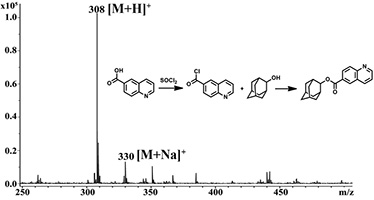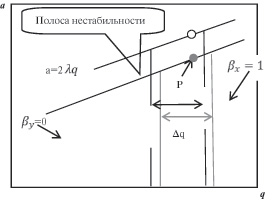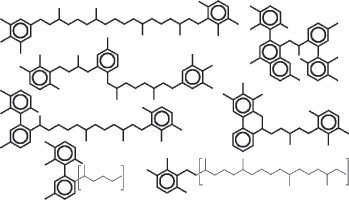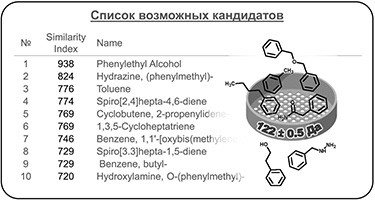T15N2
Содержание
Application of high-performance liquid chromatography/high resolution mass spectrometry for investigation of biodegradation and transformation of phenanthrene by a plasmid bearing rhizosphere bacteria Pseudomonas aureofaciens
T15N2
A.M. Zyakun, V.V. Kochetkov, V.N. Zakharchenko, B.P. Baskunov, V.P. Peshenko,
K.S. Laurinavichius, T.V. Siunova, T.O. Anokhina, A.M. Boronin
Mass spectrometry was applied to identify metabolites and estimate efficiency of phenanthrene biodegradation and transformation by rhizosphere bacteria Pseudomonas aureofaciens BS1393. The strains P. aureofaciens BS1393(pOV17) and P. aureofaciens BS1393(NPL-41) bearing various naphthalene biodegradation plasmids were used in the work. The strain BS1393(pOV17) contains the pOV17 wild type naphthalene biodegradation plasmid that determine oxidation of naphthalene to Krebs cycle metabolites. The strain BS1393(NPL-41) contains the mutant plasmid NPL-41 governing the initial stages of naphthalene oxidation into salicylic acid. The limiting stages of phenanthrene biodegradation in bacteria with various plasmids have been identified according to intermediates accumulation. When bacteria was grown on phenanthrene, the main metabolites were as follows: (a) 2-hydroxy-2H-benzo[h]chromene-2-carboxylic acid/trans-4-(1-hydroxynaph-2-yl)-2-oxobut-3-enoic acid, (b) 1-hydroxy-2-naphthoic acid and (c) salicylic acid. In strain BS1393(pOV17) metabolite (а) was observed during 1–14 days of cultivation. Unlike it, in strain BS1393(NPL-41) an insignificant amount of this metabolite was found after only 14 days. Availability of metabolite (b) during the growth of both strains is an evidence of limited rate of its further decarboxylation. Metabolite (c) as a final product was found during growth of strain BS1393(NPL-41). Contrastingly, in strain BS1393(pOV17) this metabolite was absent, which indicates the complete oxidation of phenanthrene.
Features of trialkyl phosphites revealing in reaction mixtures and their gc-ms characterization
T15N2
I.G. Zenkevich, V.E. Nosova
The interaction of aliphatic alcohols ROH with phosphorous trichloride at the absence of bases leads to the exclusive formation of dialkyl phosphonates (RO)2PHO. The same reaction can be used for synthesis of trialkyl phosphites (RO)3Р with controlling the pH of reaction mixtures by adding of N,N-dimethyl aniline (рКа 5.1 ± 0.1). The identification of trialkyl phosphites directly in mixtures without preliminary isolation is possible, but it implies the joint considering their mass spectra and gas chromatographic retention indices at the condition of identification of all constituents of these mixtures. The necessity for compliance with this condition has led to the identification of few homologues of previously not-characterized series of 2-alkoxy-1,3,2-dioxaphospholanes, which formed from the ethylene glycol as random impurity in N,N-dimethyl aniline. Using such joint GC/MS analytical parameters as homologous increments of retention indices allows distinguishing trialkyl phosphites from isobaric dialkyl phosphonates [both series belong to the same homologous group у = 12, y ≡ M(mod14)]. The absence of the signals of molecular ions in EI mass spectra of trialkyl phosphites does not preclude the evaluation of their molecular weights. Besides that, the comparison of homologous increments explains the less polarity of trialkyl phosphites comparing with dialkyl phosphonates.
Dissociative electron attachment to 2,6- and 2,5 dihydroxyacetophenone
T15N2
N.L. Asfandiarov, S.A. Pshenichnyuk, E.P. Nafikova, R.G. Rakhmeyev
Two model huminic compounds 2,6- and 2,5-dihydroxyacetophenone were investigated by means of negative ion mass spectrometry. Dissociative electron attachment cross sections and negative ion autodetachment life-times were measured in the electron energy region 0–10 eV. Adiabatic electron affinities of the compounds under investigation were evaluated. The results obtained were rationalized using DFT B3LYP/6-31G+(d) quantum chemical calculations.
Determination of total saturated and total aromatics in oils and oil products by mass spectrometry and gas chromatography/mass spectrometry with electron ionization
T15N2
E.S. Brodsky, A.A. Shelepchikov, G.A. Kalinkevich, E.Ya Mir-Kadyrova
A method of total saturated and total aromatics determination in oils and oil products by electron ionization mass spectra is presented. The contribution of saturated and aromatic hydrocarbons to the total ion current is found by solving a system of linear equations with coefficients that take stock a mutual interference of mass spectra of saturated and aromatic hydrocarbons.
Use of molecular weight and elemental composition as an additional constraint in library search
T15N2
A.S. Samokhin, K.M. Sotnezova, I.A. Revelsky
Identification of organic compounds based only on searching against electron ionization mass spectral libraries is tentative. To increase the reliability of the identification, additional information should be used. Gas chromatographic retention indices are most often used together with mass spectra. Molecular weight and elemental composition is less frequently used, because additional experiments are required to determine these characteristics. In the present paper, we examined the influence of the molecular weight, elements present in a molecule and molecular formula on the results of the library search. It is shown that, determination of the nominal mass or molecular formula slightly increases efficiency of the library search (for example, probability that the correct compound occupies the first position in the list of possible candidates increases by only 2.8 and 3.0% respectively). On the other hand, use of additional constraints in the library search can significantly reduce the number of possible candidates and simplify predicting the absence of compound in the database.
Assessment of bioproduction relevance in the photic layer anoxia conditions at formation of dispersed organic matter of source rocks and oils by mass-spectrometry data
T15N2
M.B. Smirnov, E.N. Poludetkina
A technique is proposed for estimating the content of individual groups of compounds – anoxia markers – in the photic layer of the sedimentation basin and their total content in fractions of oils and dispersed organic matter. Appropriate variants of presenting the data are analyzed. Based on the data on the common content of anoxia markers, a method has been proposed for answering the question of whether hydrogen sulfide contamination was permanent, covering the major part of the water column, or there was an episodic infection that spread to a limited water layer. These data also allow one to estimate the role of the organic matter formed under anoxic conditions, in its general balance. Composition parameter is proposed that allows one to determine the similarities in the conditions of organic matter transformation in different rocks.
Transmission for quadrupole mass filter with dipolar excitation
T15N2
K.E. Seregin , N.V. Konenkov , A.S. Berdnikov
Using the numerical simulation of the ion trajectories in the linear quadrupole with the dipole excitation(s) the mass peaks are calculated. Using this data the diagrams for transmission versus resolution are calculated both for the ideal quadrupole field and for the quadrupole field with round rods. It is shown that using the dipole excitation mode the resolution may be increased from R0.1 = 1000 to R0.1 = 2200 with 20% QMF transmission in ideal case, and for the round rods the dipole excitation along iso-line βy = 0.01 enables to increase the resolution R0.1 from 500 to 800 at 20% level transmission.
Novel reactive matrices for analysis of alcohols by matrix-assisted laser desorption/ioization mass spectrometry
T15N2
M.S. Slyundina, R.S. Borisov, V.G. Zaikin
The possibility of using a number of aromatic and heteroaromatic carboxylic acids and their halogen anhydrides as reactive matrix compounds for the analysis of alcohols of different structures by matrix-assisted laser desorption/ionization (MALDI) mass spectrometry has been studied. It is shown that acylation of alcohols with nicotinic and quinoline-6-carboxylic acid chlorides makes it possible to obtain derivatives having a high desorption/ionization efficiency under MALDI conditions, and the free acids formed as a result of the hydrolysis of anhydrides act as matrix compounds. The proposed approach is tested on a number of aliphatic, alicyclic and aromatic alcohols.











